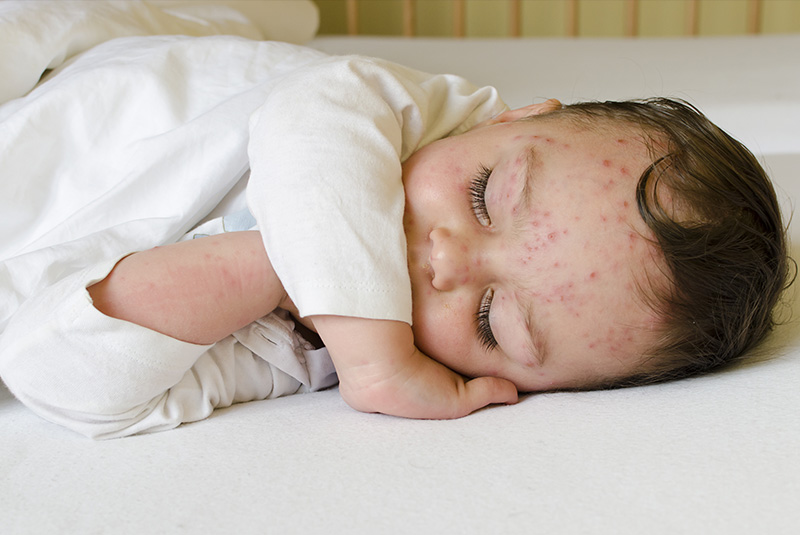

You are now leaving GSK’s website and are going to a website that is not operated/controlled by GSK. Though we feel it could be useful to you,we are not responsible for the content/service or availability of linked sites. You are therefore mindful of these risks and have decided to go ahead.
Agree Agree Agree Stay
Chickenpox, medically known as varicella 1, is a highly contagious viral infection 2 primarily affecting children 1. While it's often considered a mild childhood illness 1, it can sometimes lead to serious complications and, in rare cases, become life-threatening 1.
However, there's an effective way to protect your child from chickenpox disease: vaccination 1,3. The chickenpox vaccination protects against the virus, reducing the chances of severe outbreaks and complications 1,3.
This blog will explore the details of chickenpox, including its symptoms, complications, and the importance of the varicella vaccination in keeping children safe from this common yet preventable disease. Keep reading to learn more!
Chickenpox is an acute infectious disease characterised by an itchy red rash that eventually develops into fluid-filled blisters 1,2. This illness is caused by the varicella-zoster virus, a highly contagious DNA virus belonging to the herpes virus family 1.
The varicella-zoster virus spreads from person to person through airborne droplets or direct contact. When an infected person breathes, coughs, sneezes, or talks, tiny droplets of saliva containing the virus are released into the air and can be inhaled by others, leading to infection. Chickenpox can also be transmitted by touching the fluid from the blisters of an infected person 1,2.
Close contact with someone who has chickenpox can result in infection, especially if you are not vaccinated or haven’t had the disease before 1.
An individual with chickenpox disease is contagious from 1 to 2 days before the rash appears until all the blisters have crusted over 1. While the disease most commonly affects children between 1 and 9 years old, older children, adults, and individuals who have not been vaccinated are also at risk if they haven’t had chickenpox earlier in life 1.
Typically, chickenpox lasts about 5 to 7 days 1. However, in some cases, it can lead to serious complications, such as pneumonia, bacterial infections, brain inflammation (encephalitis), dehydration, or bloodstream infections (sepsis) 1,2. These complications are more likely in high-risk groups, including 1,2:
Vaccination effectively reduces the risk of contracting chickenpox disease and experiencing severe symptoms or complications, helping to protect both your child and those around them 1,3.
The average incubation period for chickenpox disease, which is the time between exposure to the virus and the appearance of symptoms, ranges from 14 to 15 days. However, symptoms can appear anywhere from 10 to 21 days after exposure 1.
The primary sign of chickenpox is a rash that evolves into itchy, fluid-filled blisters which eventually form scabs. The rash typically begins on the chest, back, and face before spreading to the entire body, including the mouth, eyelids, scalp, hands, and legs. Sometimes, mucous membranes and the genital area may also be affected 1,2.
A person with chickenpox can develop more than 1000 lesions 1, and it generally takes about one to two weeks for all of them to scab over 1.
In addition, a few other symptoms may appear 1 to 2 days before the rash, including 2:
While chickenpox is usually mild 1,2, it can lead to serious complications, particularly in high-risk individuals 1. These complications, though rare in healthy individuals, can include 1:
In severe cases, chickenpox may require hospitalisation and can be fatal 1.
If a woman contracts chickenpox within the first six weeks of pregnancy, it can cause serious abnormalities in the unborn baby. Infection close to the due date can be life-threatening for the baby, as its immune system is not yet fully developed 1.
Another potential complication of chickenpox is shingles or herpes zoster. After recovering from chickenpox, the varicella-zoster virus remains dormant in the body’s sensory nerve ganglia. The virus can reactivate years later, causing shingles, which is characterised by a painful rash. Adults with shingles can spread the virus to others who are not immune, leading them to develop chickenpox 1.
An effective way to protect children from chickenpox is through the varicella vaccination 1,3. The vaccination works by exposing the immune system to a weakened form of the virus, allowing the body to develop immunity without causing illness 4.
The chickenpox vaccination is effective – over 90% of children who receive two doses will be protected from the virus 3. In cases where vaccinated children contract the virus - called breakthrough chickenpox - the illness is usually milder. These children often experience fewer or no blisters and minimal fever, though some red spots may still appear 2,3.
The chickenpox vaccination is given in two doses:
Additionally, the vaccination helps prevent potential complications associated with chickenpox 1,2.
The 7-Star Vaccination Programme is a comprehensive and well-structured schedule based on guidelines from the IAP Advisory Committee on Vaccination & Immunization Practices (ACVIP) 5. It provides protection against a wide range of preventable diseases by including seven key vaccinations that cover fourteen different illnesses, including chickenpox, Hepatitis A, flu, rubella, mumps, meningitis, and more.
For detailed information and to ensure your child receives the 7-Star Protection schedule, consult your paediatrician.
Conclusion
Chickenpox is a highly contagious yet preventable disease that commonly affects children 1,2. By understanding the symptoms and complications, and taking preventive measures, parents can protect their children from the discomfort and risks associated with chickenpox.
The chickenpox vaccination effectively reduces the spread of the disease and prevents serious complications 1,2,3. Be sure to consult with your paediatrician to ensure your child receives their vaccinations on schedule and to discuss any concerns you may have about preventing chickenpox disease.
References
